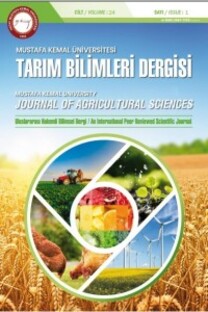Assessing salt accumulation in the root zone of tomato plant through using ordinary kriging interpolation technique under deficit irrigation regime
___
Allen GR (2003) Crop coefficients. In: Encyclopedia of Water Science (Eds. Stewart BA, Howell TA), Marcel Dekker Publishers, New York. pp. 87-90.Allen RG, Pereira LS, Raes D, Smith M (1998) Crop evapotranspiration (guidelines for computing crop water requirements). In: FAO Irrigation and Drainage Paper No. 56, FAO, Rome, Italy. pp 1-15.
Amezketa E (2007) Soil salinity assessment using directed soil sampling from a geophysical survey with electromagnetic technology: a case study. Span. J. Agric. Res. 5 (1): 91-101.
Aragués R, Urdanoz V, Cetin M, Kirda C, Daghari H, Ltifi W, Lahlou M, Douaik A (2011) Soil salinity related to physical soil characteristics and irrigation management in four Mediterranean irrigation districts. Agric. Water Manage. 98: 959-966.
Burt CM, Isbell B, Burt L (2003) Long-term salinity buildup on drip/micro irrigated trees in California. IA Technical Conference, November 18, San Diego, CA.
Cetin M, Kirda C (2003) Spatial and temporal changes of soil salinity in a cotton field irrigated with low-quality water. J. Hydrol. 272(1): 238-249.
Clark I, Harper WV (2000). Practical Geostatistics 2000. Ecosse North America Lie, Columbus Ohio, USA. 342 p.
Cressie NAC (1993) Statistics for Spatial Data. Revised Edition. John Wiley & Sons Press, New York, USA. 900 p.
Fortin MJ (1999) Spatial statistics in landscape ecology. In: Landscape Ecological Analysis (Eds. Klopatek JM, Gardner RH), Springer, New York, NY. pp: 253-279.
Hanson BR, May DE, Simunek J, Hopmans JW, Hutmacher RB (2009) Drip irrigation provides the salinity control needed for profitable irrigation of tomatoes in the San Joaquin Valley. California Agric. 63: 131-136.
Kaman H, Kirda C, Cetin M, Topcu S (2006) Salt accumulation in the rootzoneroot zones of tomato and cotton irrigated with partial root drying technique. Irrig. and Drain. 55: 533–544.
Karlberg L, Vries F (2004) Exploring potentials and constraints of low-cost drip irrigation with saline water in sub-Saharan Africa. Physics and Chemistry of the Earth, 29: 1035-1042.
Letey J, Hoffman GJ, Hopmans JW, Grattan SR, Suarez D, Corwin DL, Oster JD, Wu L, Amrhein C (2011) Evaluation of soil salinity leaching requirement guidelines. Agric. Water Manage. 98: 502-506.
Mert BA, Dag A (2017) A computer program for practical semivariogram modeling and ordinary kriging: a case study of porosity distribution in an oil field. Open Geosci. 9(12):663–674.
Sayari N, Brundu G, Mekki M (2016) Mapping and monitoring an invasive alien plant in Tunisia: Silverleaf nightshade (Solanumelaeagnifolium) a noxious weed of agricultural areas. Tunisia J. Plant Protection, 11: 219-227.
Vanderborght J, Vereecken H (2007) Review of dispersivities for transport modeling in soils. Vadose Zone J. 6: 29-52.
Webster R, Oliver MA (2001) Geostatistics for Environmental Scientists. John Wiley & Sons, Chichester, England. 330 p.
- ISSN: 1300-9362
- Yayın Aralığı: 3
- Başlangıç: 1996
- Yayıncı: Mustafa Kemal Üniversitesi Ziraat Fakültesi
Burçak KAPUR, Mahmut ÇETİN, Harun KAMAN, Eser ÇELİKTOPUZ
Arduino tabanlı dijital psikrometre tasarımı
Ali Demir KESKİNER, Mahmut ÇETİN, Takanori NAGANO
Gaziantep ili Nizip ilçesi zeytin bahçeleri topraklarının bor durumunun belirlenmesi
Kerim Mesut ÇİMRİN, Mehmet YALÇIN, Neslihan KELEŞ
Mehmet Sait KİREMİT, M. Hakan ARSLAN, Alieu SAİDY
Memiş KESDEK, Ayşe USANMAZ BOZHÜYÜK, Şaban KORDALİ
Serdar POLAT, Korkmaz BELLİTÜRK, Meryem METİNOĞLU
Yeşim BOZKURT ÇOLAK, Attila (ve diğerleri) Yazar, Serpil G. TANGOLAR, Gülşen DURAKTEKİN, Engin GÖNEN
